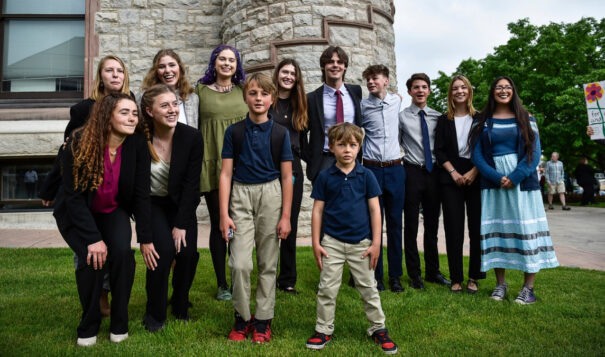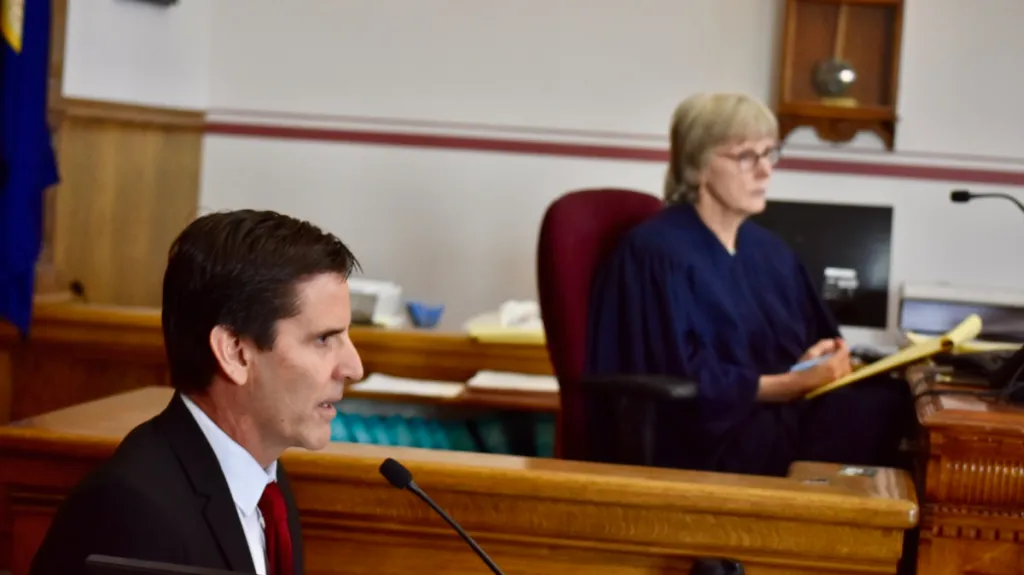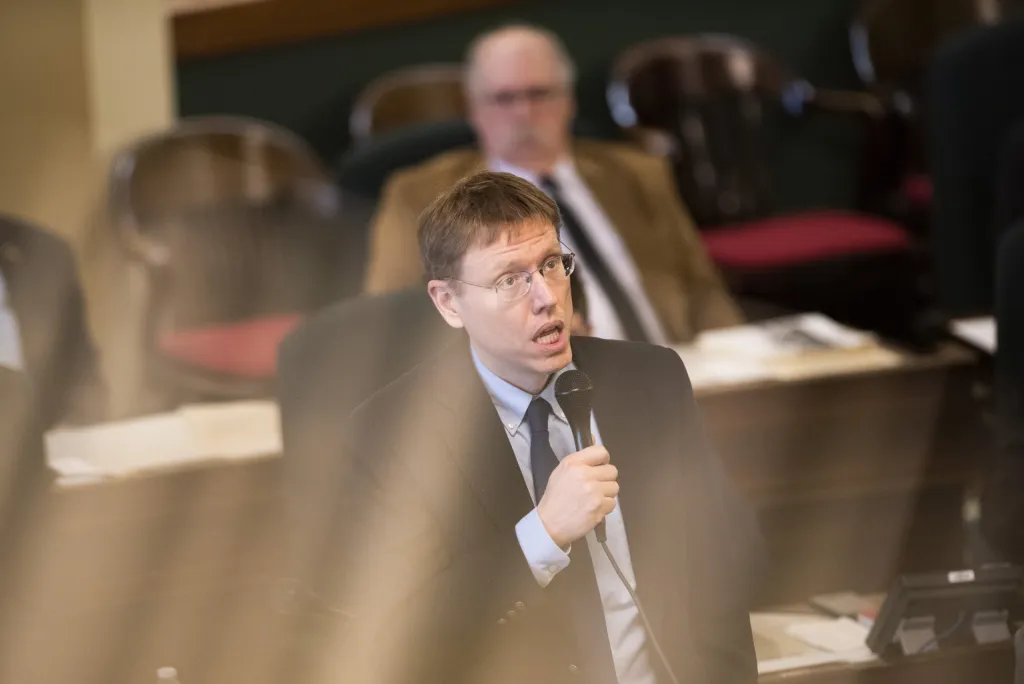News Based on facts, either observed and verified directly by the reporter, or reported and verified from knowledgeable sources.
‘This changes everything’: Experts respond to Held v. Montana climate ruling
 Youth plaintiffs in the climate change lawsuit, Held vs. Montana, pose for a photo outside the Lewis and Clark County Courthouse on June 12, 2023, the first day of hearings in the trial. Credit: Thom Bridge / Independent Record
Youth plaintiffs in the climate change lawsuit, Held vs. Montana, pose for a photo outside the Lewis and Clark County Courthouse on June 12, 2023, the first day of hearings in the trial. Credit: Thom Bridge / Independent Record
Legal, scientific and industry experts agree the ruling in Held v. Montana will have lasting consequences. But will it result in changes to Montana’s energy policies?
On Monday morning, when a Montana judge issued a ruling favoring young environmental advocates in the constitutional climate change lawsuit Held v. Montana, Lander Busse, one of the 16 youth plaintiffs, was in a raft on the Flathead River.
When told by his father that the decision favored the plaintiffs, Lander said, “Hell yes, we won, and I am going fishing,” before floating out of cell service, according to his father’s telling of the exchange.
As Busse, 18, drifted out of reach of reporters, the response to the landmark decision rippled across the globe, and in its wake a torrent of analysis has poured in from legal observers, scientific experts, environmental advocates, policymakers and industry stakeholders, all trying to paint a picture of Montana’s future through the legal lens of the verdict, as well as its long-term policy implications.
Held v. Montana made history as the first youth-led constitutional climate change lawsuit to go to trial, with a seven-day trial unfolding in a Helena district courtroom in June.
The lawsuit alleged the state had violated the plaintiffs’ constitutional right to a “clean and healthful environment,” and focused on a provision in the Montana Environmental Policy Act (MEPA) that prohibits state agencies from considering greenhouse gas emissions and climate change impacts while conducting environmental reviews.
The ruling by Lewis and Clark District Court Judge Kathy Seeley is the first legal opinion of its kind, spelling out the environmental harms caused by greenhouse gas emissions as well as the effects of climate change on the physical and mental well-being of young people.
Michael Gerrard, the founder of Columbia Law School’s Sabin Center for Climate Change Law, said he was “smiling ear to ear” when he read the Aug. 14 decision, which he characterized as the “strongest decision on climate change ever issued by any court.”
“The court resoundingly affirmed what the climate scientists are saying, and it will become ever harder to attack basic climate science in the court, where facts matter,” Gerrard said.
The 103-page Findings of Fact, Conclusions of Law, and Order draws a correlation between greenhouse gas (GHG) emissions and tangible changes to the environment, and it appraises Montana’s contribution to the broader consequences of climate change.
“Montana’s GHG contributions are not de minimis but are nationally and globally significant. Montana’s GHG emissions cause and contribute to climate change and Plaintiffs’ injuries and reduce the opportunity to alleviate Plaintiffs’ injuries,” according to language in the ruling that zeroes in on one of the state’s foundational arguments.

Six states and roughly 150 countries have codified the right to a clean environment in their constitutions, similar to the Montana provision the case was predicated on, and legal experts say the Held ruling may come into play in those jurisdictions.
“There’s a lot of excitement about Montana playing an early role in developing new legal approaches to this problem,” said Michelle Bryan, a University of Montana law professor who specializes in natural resource and environmental law. “All these other cases we see now are potentially going to trial, and this decision, and whatever comes out on appeal, will be read by judges all over. Even though they’re not bound by this precedent, they’ll be influenced by what Judge Seeley and the Montana Supreme Court had to say.”
Emily Flower, a spokesperson for the Montana attorney general’s office, said the state will appeal the ruling. In a statement, Flower characterized the ruling as “absurd” and called Seeley an “ideological judge.”
Speculating about what the Montana Supreme Court might do on appeal, retired Supreme Court Justice Jim Nelson called the case a “slam dunk home run” and said he expects the state’s high court will have a difficult time overturning the decision.
“I think this is one of the most powerful decisions I’ve ever read on the environment in Montana,” said Nelson, who sat on the state Supreme Court for nearly two decades.
Nelson said the decision’s biggest implication is the court’s finding that climate change is covered by Article II, Section 3 of the Montana Constitution, the right to a “clean and healthful environment.”
“That’s important. One could think it’s common sense to make that connection, but the court has never said that,” Nelson said. “She also found that the state and Legislature have violated their mandatory duties under Article IX, Section 1 to maintain and improve the environment for this and future generations. That’s going to come out in other environmental cases that go before the court.”
Gerrard and Bryan both highlighted the extent to which Seeley’s ruling focused on the source of climate change and the individual harm reported by the plaintiffs — a section spanning roughly 50 pages — and the state’s role in furthering both.
Bryan said future questions will revolve around whether an agency review of greenhouse gas emissions adequately meets the constitutional provision for a clean and healthful environment. “The court’s saying that the climate isn’t an issue you can skip during an environmental review — our Constitution requires you to consider it,” she said.
The ruling also suggests that part of an environmental review is considering alternative actions and projects, which in the energy arena could mean considering alternatives to carbon-based fuels.
Bryan said the impetus is now on state regulatory agencies like the Department of Environmental Quality (DEQ) and the Department of Natural Resources and Conservation (DNRC) tasked with permitting major energy projects to implement changes in Montana.
“The most important part of the ruling is that the government bodies like the DNRC, DEQ and [Montana Department of Transportation] will have to figure out the best way to consider greenhouse gas emissions, which is something other states, and the federal government, are grappling with,” Bryan said. “A lot of work is left to do in terms of figuring out how to implement greenhouse gas reviews into the agency processes.”
In her verdict, Seeley wrote that it is possible to calculate the amount of carbon dioxide and greenhouse gas emissions that result from fossil fuel extraction, processing, transportation and consumption activities authorized by state agencies. She cited permitting decisions prior to 2011 when agencies quantified and disclosed such emissions. The ruling, however, does not instruct the state on how to quantify emissions, or where the line should be drawn to decline a new permit.
Anne Hedges, co-director of the Montana Environmental Information Center, characterized the ruling as both far-reaching and unprecedented during a Public Service Commission meeting on Aug. 15. Hedges, who served as an expert witness for the plaintiffs and has tracked energy policy in Montana for three decades, said that’s largely due to the decision’s implications for the energy permitting process.
“This changes everything,” she said. “The court ruled that the state must be able to deny fossil fuel projects — something the state has never done before.”
“The state must either have discretion to deny permits for fossil fuel activities when the activities would result in greenhouse gas emissions that cause unconstitutional degradation and depletion of Montana’s environment and natural resources, or the permitting statutes themselves must be unconstitutional,” Hedges said, pulling language directly from the ruling.
In addition to finding that cataloging greenhouse gas emissions is technically feasible, Seeley wrote that a transition to renewable energy is “economically feasible and technologically available to employ in Montana.” She added that there is a roadmap for a transition to such energy sources available that will “create jobs, reduce air pollution, and save lives and costs associated with air pollution” in addition to garnering climate benefits.
During the trial, Stanford University Atmosphere/Energy Director Mark Jacobson said Montana has “incredible” renewable energy potential, particularly in regard to wind generation. Jacobson said his modeling demonstrates that the state could easily meet its energy needs and keep the grid stable by pairing existing hydropower generation with expanded wind and solar power, backed up with battery storage.
Seeley also cited Jacobson’s calculation that wind and solar cost about half what a new natural gas project does, and are “even cheaper compared to coal” in her order.
Entities representing or heavily invested in the fossil fuel industry expressed dismay with the decision and emphasized the uncertainties it raises, while Montana-based renewable energy advocates said it will accelerate a transition that’s already underway.
Montana Petroleum Association Executive Director Alan Olson said the ruling amounts to job security for lawyers and will prove difficult to implement, given the technical challenges associated with emissions accounting. Olson also said he fears an abrupt transition to renewables would be expensive for ratepayers when electricity demand surges and would shrink the tax and philanthropic footprints of companies like Signal Peak Energy, which owns a coal mine in Musselshell County that employs about 280 people.
Olson added that whatever regulatory shifts are coming, they won’t happen overnight. “It’s going to be a long process to conform with this,” Olson said. “You’re going to need statutory changes, you’re going to need rule changes.”
Steve Fitzpatrick, a Republican lawmaker from Great Falls who urged his colleagues in the Legislature to pass Senate Bill 971, a measure barring the state from considering greenhouse gas impacts in environmental reviews that Seeley struck down in her ruling, echoed that sentiment. Between the state’s appeal and the Legislature’s input in future legislative sessions, “it’s too early to say what kind of impact this case is going to have,” he said.
“In my opinion, all [Seeley] has really done is given the Legislature an invitation to come in and redraft MEPA with respect to greenhouse gas impacts or out-of-state impacts,” he said, adding that in his estimation Seeley’s order gave the plaintiffs “20%” of what they wanted.
A requirement to analyze greenhouse gas emissions might make that process “longer and more cumbersome and more expensive,” but it doesn’t amount to a wholesale prohibition on new coal mines or gas plants, he argued.
Makenna Sellers, executive director for the Montana Renewable Energy Association, said in an email that the Held ruling could make carbon-free projects more attractive in Montana, and described her industry’s contribution as “part and parcel to Montanans’ constitutional right to a clean and healthful environment.”
Bruce Spencer, who lobbies on behalf of large wind and solar developers for the Montana Energy Business Alliance, said he anticipates clean energy will continue expanding in Montana so long as the regulatory climate remains stable for would-be investors.
“MEBA is just hopeful that Montana’s business conditions will continue to permit renewable energy development as part of Montana’s energy portfolio,” he added.
Despite vast coal reserves — more than any other state in the country — the state is trending more and more toward renewables, according to a 2023 report released by DEQ. “Development of new in-state generation is being led by wind resources, natural gas, solar assets and, increasingly, large-scale batteries.” The agency’s analysis found that wind-generated capacity has doubled in the past decade and is close to equaling coal-fired capacity in the state.

Bryan, the University of Montana law professor, found irony in the decision being handed down at a time when Montana is facing multiple wildfire outbreaks, extreme heat, record low streamflows and drought conditions — all environmental impacts that scientists tied to climate change during the trial.
“It just underscores the problem that stimulated the trial: We’re going in the wrong direction,” said Jack Stanford, the former director of the Flathead Lake Biological Station, who served as an expert witness for the plaintiffs. “Everyone who depends on water and Montana’s rivers is going to feel the effects of this climate warming and the loss of flow and volume in our streams and rivers.”
“I think we’re just pleased that the trial went our way and hope that Montana’s government steps up to the plate and takes a few swings in favor of the environment instead of fossil fuel development,” Stanford said.
This article is part of a series on the youth-led constitutional climate change lawsuit Held v. Montana. The rest of the series can be read at mtclimatecase.flatheadbeacon.com. This project is produced by the Flathead Beacon newsroom, in collaboration with Montana Free Press, and is supported by the MIT Environmental Solutions Journalism Fellowship.
